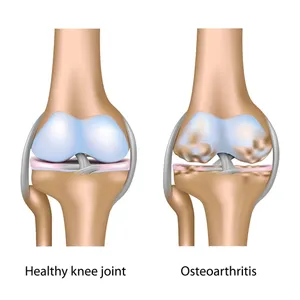
OAK targets the medial (or inner) knee, or one (unilateral) or both (bilateral) sides of the knee joint if the cartilage surrounding the joint suffers injury or begins to wear away over time. OAK is also common in athletes who play high-impact physical sports (like football or basketball) and who’ve suffered a past injury to the knee area.
Even though osteoarthritis can occur in any joint, it’s most common in weight bearing joints like the knee, with symptoms consisting of a deep aching pain that worsens following activity, stiffness in the morning and after long periods of inactivity, swelling of the area around the joint, and a rubbing or crackling in the knee joint during movement.
OAK commonly exists in the following patients:
- Overweight individuals who put excess impact and pressure on the knees, which are weight-bearing joints
- Those with a family history of the disease
- Heredity predisposed patients with existing joint or cartilage dysfunction
- Folks who have suffered a knee injury or break
- Those who put repetitive stress on the knees, by kneeling or squatting repeatedly and in bad form in their job or sport for long periods of time



